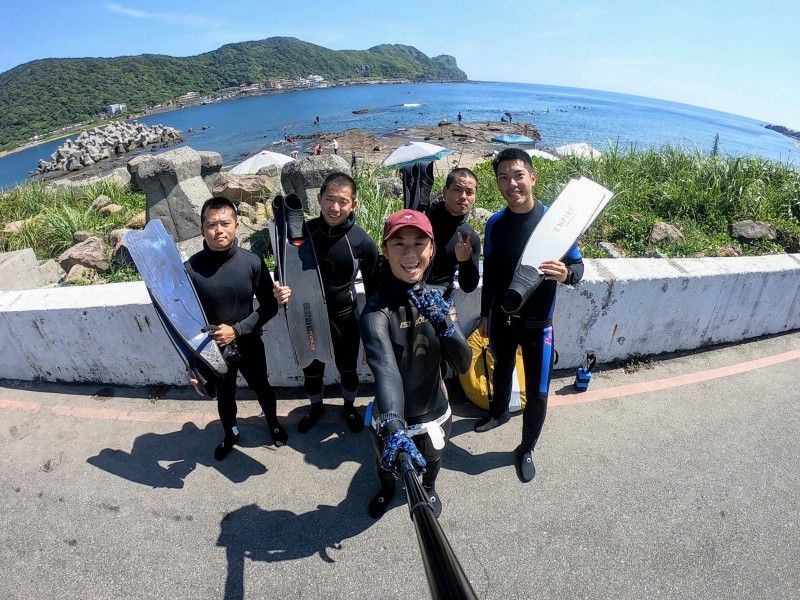Day 2: Ocean Course | AIDA 2 Self-Dive Course Experience

After the first day of subject and swimming pool courses, the second day followed the actual combat at sea. I really advise everyone to go to bed early the day before, or even plan to revise your sleep habits two weeks before, so that you will be more comfortable during the sea trip.
Flat pressing exercises
Before all classes start, you can practice at home by yourself, in addition to holding your breath, it is flat pressure. Flat pressure is the abbreviation of balanced ear pressure. Because the course is compact, the coach will actually decide whether or not to take the exam based on everyone's progress. For example, most of us still cannot climb too deep because of flat pressure on the third day. Naturally, it is impossible to test what to bow and dive for 16 meters.
Although there are very few people who can pass AIDA 2 after only three days of class (the coach said in the class that 10% of the people will pass it), even if the class is not completed within a year, you can still make up the test with the coach for free. But if you really want to be a wizard in three days, I think it will be very helpful to confirm that you can press down before class.
Valve type (Valsalva)
The valve type uses the force of the diaphragm to squeeze the air, forcing the Eustachian tube to open and sending air into the middle ear. This should be done by many people before class. It is the action of pinching the nose and exhaling vigorously, which may be very common when flying.
However, under the influence of water inversion and depth, the diaphragm force required to force the opening of the Eustachian tube will be much greater than on land, and it will become more and more difficult to do as the depth increases, so it is recommended to practice the Franzalo style. Flatten.
Of course, there are wizards who can go all the way to the highest, farthest and most vast.
Frenzel
Franzo also squeezes air to forcibly open the Eustachian tube, sending air into the middle ear. Unlike the valve, it uses the muscles of the base of the tongue, which makes it a mysterious movement.
In class, the coach would teach you to lift your tongue, and even Grandpa Franco would say that you just need to focus on lifting your tongue. But in fact, different people may get stuck in different places. For example, when I practiced frantically the next night, I found out that the position of the base of my tongue was correct, but the position of the soft palate was wrong, which blocked the air. Access to the nasal cavity (the entrance of the Eustachian tube is in the nasal cavity).
I myself feel that it is very difficult to write the Franzo movement into a manual-like standard process. I asked some friends who have learned self-diving and said that they can only understand and not express it in words, so I suggest that you read various articles and videos, and try them all. Try it out, maybe someone's experience or teaching is similar to yours, and you'll pass.
For example, the self-dive Youtuber shut down and recorded 14 videos just for Franzopin. Looking at this number, you can imagine how mysterious it is.
own practice experience
My own experience is that in addition to lifting the base of the tongue, it is also necessary to ensure that the air can enter the nasal cavity from the mouth. When we hold our breath on land, we are used to closing the passage of air to the nasal cavity (do not know the detailed name), so I also do the same when I go to the water to hold my breath. , so that it is useless to lift the base of the tongue, and I want to say whether I have been lifting it in the wrong position and trying to lift it randomly.
But in fact, Franzo will pinch his nose when he is flattening. At this time, the passage of air to the nasal cavity must be kept unobstructed. Later, when I practiced on land, while lifting the base of the tongue, I had to keep the air coming out of the nose. Remember this feeling and then pinch the nose. Do it, it will be soon, and then I also found that the position of the base of my tongue should actually be right (sorry for the base of my tongue, I wronged you).
Then the feeling of the tongue squeezing the air into the nasal cavity is different from the feeling of simply lifting the base of the tongue. At first, I will try to fill the mouth with air and then practice lifting the base of the tongue, and I will compare how I can grasp it.
Confirm the smoothing is successful
Because the head is turned upside down when diving in the water, the way to check whether the flat pressure is done correctly on land is of course to turn the head upside down. In this part, I also refer to Guan Guan's teaching:
But it's also important to note that you should be as strong as you do a Franzo in reverse .
If we do not need to flatten the pressure (for example, when the ear pressure is unbalanced in an airplane), we will use the valve type, because the pressure inside the ear is already greater than the outside, and the eardrum will be pushed out, so we will feel that the ear is blocked. Sounds that don't come out too much, like a layer of walls.
Then when you turn your head upside down to be a Franco, you should be able to do it to this extent. Instead of feeling that "the ear seems to have a feeling" and "the ear seems to have a slight pop", it is enough, because this means that the air is not really pushed into the middle ear, and the water should be stuck.

Prepare before going to sea
wear cold clothing
The first thing to do is to wear a cold jacket on the shore, which is really hard enough. There is a relatively strong friend in the course. Seeing him wear it to the point of being world-weary, I really feel that it is fortunate that he has a small skeleton and shaved his head, and the process of wearing it is a little easier.
Mirror defogging
The mask will be put on before going into the water. The coach taught us to use saliva to remove fog. It is recommended to spit a little more saliva and then wipe it evenly and thoroughly. very troublesome.
breathing tube adjustment
The mouthpiece of the snorkel and the tube are actually separate and rotatable. Adjust to a better position and then go into the water. You don’t want to adjust the snorkel on the way. Unless you are very good at water, you have to wait directly for the trainer. Good float lying on top of the adjustment.
Motion sickness pills
People who are prone to seasickness or are prone to motion sickness, airsickness, seasickness, MRT, motorcycles, dragons, and various means of transportation can prepare motion sickness medicine. Remember to ask the coach about the timing of taking it, or take it immediately after arrival.
large tank of water
Then we bought a large can of water together and put it in the coach's float. It is recommended to bring water. People who are not used to activities in the sea will drink seawater accidentally, and people with poor stomach will be more prone to nausea.

go to sea
spit out sea water
The reason why I specifically say this is because on the first day I went to sea, I would swallow the saliva in my mouth. After a while, I began to feel that my stomach was burning and I wanted to vomit. It was not because of the dizziness, but too much salt entering my stomach. irritates the gastric mucosa. Since salt can stimulate saliva secretion, it is recommended that if you feel that there is too much saliva in your mouth, don't swallow it, just spit it out.
fins
Long fins will be worn in places where you can still step on the ground after going out to sea. Because you have a lot of activities when wearing fins, it is recommended to wear them with full breathing and holding your breath. Otherwise, people who are afraid of water should only wear fins while breathing into water. What do you think you are going to do today?
After going out to sea, you will start kicking your fins to the designated point. If the pool class finds someone who can’t kick your fins well, this journey will be the most crashing part. Just be sure to tell yourself to take it easy and really kick your fins. If you are thinking, "Ahhhh, I can't step on it all the way", "Ahhhh, the breathing tube is flooded", "Ahhhh, what should I do if the coach is so far away from me", etc., you may soon get cramps.
I don’t think it’s okay if I can’t play, just play slowly, and watch how the players or coaches on the same team are playing. Learn and sell now and adjust slowly. Having a point of focus that can be distracted will make it easier for you to forget. The fear of going to sea.
Waiting for the coach to set the float
After the coach brings everyone to the designated spot, he will start to set up the float. During this time, you must stay in place as much as possible. You can try standing swimming by yourself first. You can imagine that it is standing and kicking fins. The action is the same as that of a flat kick, but the speed can be slower and the force used should be smaller, but the action must be the same.
If you can't swim upright, you can go to see the fish in the water (although we didn't have many days), let yourself relax and take a breath and adapt to the sea water. Because of the relationship of wearing cold-proof clothing, basically don't move around and breathe normally, It should be able to float easily, and the focus is still to relax and not be nervous.
sea course
Once the trainer has set the float, the lesson will begin. The project of teaching at sea will start with rope climbing, after getting used to the sense of space on the head and feet, and the movements of balancing ear pressure, then start to practice bowing into the water.
Rope diving
Rope climbing means that there will be a rope under the floating ball. The coach will ask us to turn our body from the top of the head to the bottom of the foot. Instead of kicking the fins, we dive by pulling the rope. Compared with the slower diving speed of kicking fins, it is better to practice ear pressure balance.
It is recommended not to be impatient here, practice ear pressure balance, and familiarize yourself with the feeling of holding your breath in the water. Because breathing in the water will cause fear, fear of drowning, etc., so the knowledge of breath-holding learned on the first day may be forgotten, try to recall and relax, wait until you are sure that your ear pressure can be balanced, and then try to increase the pressure. Dive depth.
bow into the water
There are fixed steps for bowing into the water, which the instructor will explain during the class.
It is also recommended not to be impatient. At the beginning, I often forgot to do a flat pressure on the water surface first. After going down, I felt "Aah, don't go down so fast, ah, ah". It was too late to do the flat pressure and had to get out of the water as soon as possible. .
Then after entering the water, because there is only a piece of blue water and fish, and I am not used to inversion, I will lose the sense of space at first, including not knowing how straight my feet should be lifted, and whether my body is diving vertically. The coach also saw my problem and gave me some advice, two of which I find most useful are to see your fins when you bend over.
The part about seeing your fins is making sure you bow enough, but not so much that you roll over 180 degrees back to the surface. Keeping your neck upright and your eyes looking at the direction of your body during the bowing process can also prevent yourself from looking at the bottom of the sea.

About the next day.
Aside from the confusion and nervousness when we first started out at sea, after getting used to it, we can actually start to focus on how to do ear pressure, how much is enough to bow, and so on. Because I didn't practice Flanzo's flat pressure in advance, I probably only dived at most three meters on the second day, which is almost the depth of my bow.
There are people who think that they will pass the test after the three-day course. If they don’t climb to the end and see the lead the next day, I guess the coach will not arrange for you to take the test. After I practiced with Franco on the second night, I climbed to the end as soon as I went to class on the third day, but it was still too late for the exam.
On the morning of the third day, we will take the written test before going to the sea, so we had a review meeting at the homestay the night before. Basically, you can answer the knowledge review at the end of each chapter of the course material, and if you listen to the class carefully on the first day, you should be fine.
Like my work? Don't forget to support and clap, let me know that you are with me on the road of creation. Keep this enthusiasm together!

- Author
- More